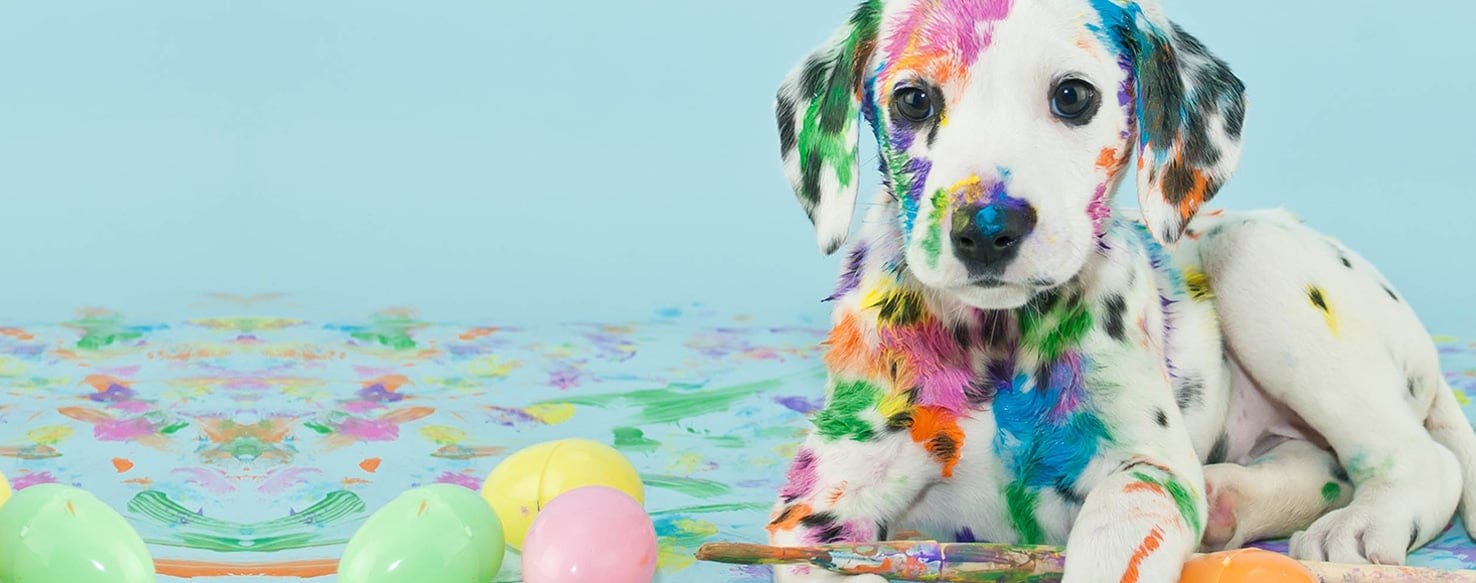- Home
- The Daily Wag!
- Senses
- Can Dogs Smell Paint?

There's nothing quite like a fresh coat of pain to give the walls of your home a little life, color, and boost. But, painting with dogs in the house can be a dangerous situation, so it's important that you're cautious. Dogs are very, very smell-driven, and something strong, like paint, will certainly catch their interest. And as any dog owner knows, if your dog sniffs it, your dog is going to lick it, and unfortunately, paint is very toxic for pups. Even the fumes from paint can cause your doggo some damage.
So, how can you keep your pet safe from paint when they can't get enough of the smell? How can you make sure that your paint situation is safe for your pooch? Read on to find out!
When it comes down to it, your dog can definitely smell paint, and dogs, being driven by their sense of smell, will most likely want to get up close and personal with your paint cans in order to properly investigate what's going on.
In a lot of cases, this isn't harmful, but with paint, it's a different story. In short, pets and paint don't mix, especially when it comes to the fumes and potential for accidental ingestion. Your pup is far more sensitive to the fumes than you realize, and if your doggo is having trouble with the paint, you need to be aware.
Look for signs like vomiting, diarrhea, and incoordination. If your pet is unable to walk normally, can't focus, and frankly, looks a little drunk while they're getting from point A to point B, it's probably from the paint fumes. Additionally, your pup might face things like system depression, lethargy, weakness, difficulty breathing, and tremors.
Body Language
Signs your dog might be affected by paint fumes or paint ingestion include:
- Shaking
- Cowering
- Panting
- Weakness
- Tail Tucking
- Pupils Dilated
- Whale Eye
- Sleepiness
Other Signs
Here are a few other signs that the paint you're using is affecting your dog:
- Vomiting
- Drunk Walking
- Confusion
- Incoordination
- Diarrhea
Paint is best known as the group of emulsions that consist of pigments in liquid that help with design, protective coatings, and giving your house a splash of much-needed color. But did you know that paint, made up of chemicals and toxins, has had a long, complicated history? Paint, though still not a great thing to smell or ingest, used to be much more dangerous than it is now.
Initially paint pigments were made with lead, a type of paint that is illegal to use now because of numerous case of paint chips (which were eaten by children) causing mental retardation, death, and other ailments. The Consumer Product Safety Commission banned the use of lead in consumer paint in 1978, making paint much safer. Still, paints contain VCOs, something we'll dive into in a moment, which can make them dangerous to inhale and accidentally ingest.
Most types of paints are toxic for your dog because they contain harsh, poisonous chemicals that will not digest properly in your dog's system. One of the most dangerous paints is lead paint, but other types of paint also can cause irritation to your dog's systems.
Paint contains chemicals called VOCs, or volatile organic compounds, and they are released into the air as you paint. These VOCs are dangerous because they are known carcinogens, which have been linked to cancer. Another reason these VOCs are dangerous is because they contain other chemicals like benzene, methylene chloride, and more.
When it comes to painting and your pup, a lot of the training is going to come down to you and how you handle the process. While you should train your dog to listen to basic obedience commands like "no," "stay," and "leave it," there's going to be a lot more factors when it comes down to it.
For example, never leave paint trays or open cans of paint laying around. Your dog, who can definitely smell the paint, will be attracted to the strong smell and likely will want to sniff, lick, and inhale the paint. Additionally, during the painting process, make sure your dog is either outside or in a different, ventilated room and cannot access the paint.
Both ingesting the paint and smelling the fumes can be very dangerous for your dog, so keeping them away from your paint project is going to be vital. That being said, make sure you've trained your dog to feel comfortable in their crate or in their special room so they don't take on any destructive behaviors while you have them secured away during your project. Additionally, you must make sure you have windows and doors open while you're painting in order to keep your dog away from the harmful fumes.
Have questions or concerns about your pet?
Chat with a veterinary professional in the Wag! app 24/7.
Get Vet ChatSafety Tips for Pets Around Paint:
- Leave your dog outside while you paint.
- Look for dog-friendly paint options that won't hurt your pup if digested by accident.
- talk about precautions with your vet.
- keep your dog outside or in their crate while your paint is drying.
- Make sure you open and windows and doors while you paint to fan the fumes out.
- !do not allow your dog to smell the paint.
Written by a Great Dane lover Hanna Marcus
Veterinary reviewed by:
Published: 04/27/2018, edited: 04/06/2020
More articles by Hanna Marcus
